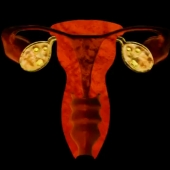Amniocentesis is a test used to determine whether your unborn baby has any genetic abnormalities (genetic amniocentesis) or whether its lungs are developed enough for birth (maturity amniocentesis).
The most common reason to have an "amnio" is to determine whether a baby has certain genetic disorders or a chromosomal abnormality, such as Down syndrome.
The amniotic sac is in the uterine cavity. The amniotic sac is the fluid-filled structure inside a pregnant woman's uterus within which the baby lives. Fetal cells, proteins, and fetal urine freely move within this sac.
Amniocentesis (or another procedure, called chorionic villus sampling (CVS)) can diagnose these problems in the womb. Amniocentesis is usually done when a woman is between 14 and 16 weeks pregnant.
Before the start of the procedure, a local anesthetic can be given to the mother in order to relieve the pain felt during the insertion of the needle used to withdraw the fluid.
Your doctor will use a long, thin needle to collect a small amount of amniotic fluid. This fluid surrounds and protects the baby while it is in your womb. It is then tested for certain genetic conditions, including Down syndrome, spina bifida, and cystic fibrosis.
The test results can help you determine whether to continue with your pregnancy. The test can also tell you whether or not your baby is mature enough to be born. It is also helpful for determining whether you need to deliver early to prevent complications from your pregnancy.
The video describes the amniotic fluid and its function in determining congenital defects in the child. The reasons for performing it in the second and third trimester are stated. The care required in the procedure is described and the post-surgical precautions are stated.
- 2582 views













